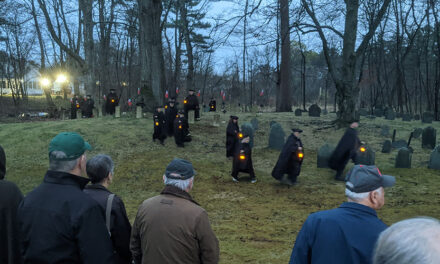Published in the March 1, 2017 edition
By BOB BURGESS
LYNNFIELD — National Development this week submitted a new plan for a medical building at the expansive MarketStreet outdoor lifestyle center.
This facility would be smaller in size than the one proposed earlier this month, but what matters most to neighbors is its impact on area traffic and its prime location near Davio’s Northern Italian Steakhouse on the Walnut Street side of the town’s premier shopping, dining and entertainment destination. The latter issue, some feel, is a direct violation of an agreement neighbors and the town hammered out with National Development several years ago.
At a Planning Board meeting Monday, National Development Managing Partner Ted Tye told members he would like to withdraw the original plan for a three-story, 42-foot high, 54,000 square foot building and replace it with one calling for a two-story, 30-foot high, 40,000 square foot structure.
Before National Development’s withdrawal of the original medical office building proposal, however, a letter from Wakefield Town Administrator Stephen P. Maio was put into the public record. In it, Maio expresses concerns about sewage disposal and water usage at MarketStreet, their impact on Wakefield and the fact that any major modification to the MarketStreet plan is subject to an amended and restated sewer agreement between the town of Wakefield, the town of Lynnfield and the MWRA.
Tye told planners National Development was downsizing its proposal for what is expected to become a Lahey medical office building with an urgent care component based on the input he heard from the Planning Board and neighbors at a meeting on Valentine’s Day. The developer is scaling back, Tye said, despite a decision from Town Counsel Thomas A. Mullen stating the original three-story building “is not prohibited” at MarketStreet if it is kept under a maximum allowable height of 45 feet.
By way of comparison, Tye said, the proposed two-story medical office building would be a little shorter than the existing Al Merritt Media and Cultural Center National Development built for the town at MarketStreet.
Tye spoke only briefly about the new plan, which was submitted to the town during the day Monday. The Planning Board set a formal public hearing for Thursday, March 23. This will allow other town boards and officials time to review it and offer their input before the hearing.
In a memo to the Planning Board February 24, Mullen also wrote about whether medical offices are allowed at MarketStreet, which occupies Lynnfield’s Planned Village Development District (PVDD). Among the uses expressly forbidden in the PVDD are “(f)acilities that generate, treat, store or dispose of hazardous waste….I understand that it is contemplated that the medical offices in the new building will generate some medical waste, such as blood.”
While Mullen told the Planning Board this could be a “potential roadblock” to a Lahey facility at MarketStreet, part of the corresponding PVDD zoning bylaw provides ‘that despite the general prohibition of ‘(facilities) that generate, treat, store or dispose of hazardous waste,’ the ban does not apply to ‘(v)ery small quantity generators as defined (under state regulations)….
“While it does not appear, to my layman’s eye, that (a list in the memo includes) the kinds of wastes likely to be generated by a medical office, I cannot say for sure. I certainly have insufficient information to say whether the volume of waste anticipated to be generated exceeds the thresholds set forth (earlier in the memo).
“I believe, therefore, that your board needs to inquire of National Development exactly what kinds and quantities of wastes are expected to be generated, treated, stored or disposed of in the new facility. I recommend that you ask them to show that the wastes in question (a) does not qualify as ‘acutely hazardous waste’ (as defined by state regulations) and (b) will not be generated or accumulated in excess of the maximum quantities set forth in the regulation quoted above. If the proponent can satisfy you on these factual issues, then I believe the proposed medical office use would be allowed in the PVDD.”
Abutters express numerous concerns
Planning Board Chairman John Faria allowed for public input at Monday’s meeting, and it was much the same as the views expressed two weeks ago.
Patrice Lane’s Patricia Campbell had many concerns. First, she said, the MarketStreet development she voted for is not as it appears today. Parking, for one, is not parallel to the curb. The structures there are not of Colonial design. Store employees, she said she was told, have to park in Wakefield and walk up the hill to work. She said she went to the outdoor lifestyle center twice last week and the easiest place to find parking was near Davio’s, where Lahey wants its office building to be situated. She also discussed the alleged positive impact MarketStreet has had on taxpayers’ wallets and the increase in responses by the town’s public safety departments.
Wally McKenzie, 4 Debston Ln., argued — with the aid of slides — that the location of the office building is a violation of the agreement National Development has with the town. “If this was on the northerly or westerly side (of MarketStreet) no one would oppose this.” He said, among other things, that the agreement states, “Taller buildings should be located toward the northern and western portions of the District to reduce their visibility from public ways and Gateways.”
Karen Ruecker of Fernway, a MarketStreet neighbor, said traffic in the area is horrible. She asked whether there would be public transportation coming to the outdoor lifestyle center, and whether there would be a parking garage. Two other Fernway residents also talked about the big increase in traffic volume on Walnut and Salem streets.
Alexandra Road’s Joe DeMaina said that given the height and location of the proposed structure, “You will really be able to see this building, and this was not part of the agreement.” He wondered how many people would work at the proposed facility, whether traffic would be alleviated, whether the area needs another formal traffic study, how the building would be lit late at night and in which direction a Lahey sign would face.
“Will it face Walnut Street so everyone living in the area is looking at it all the time?” DeMaina asked.
These are just a few questions National Development professionals will be answering in the weeks ahead.




